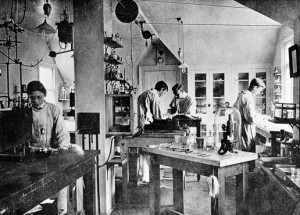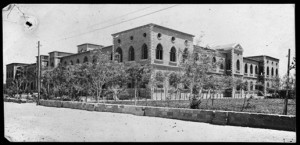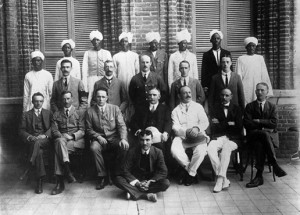The Stannington Sanatorium Project has been generously funded by the Wellcome Trust, a  charitable foundation designed to aid research into, amongst others, Medical Humanities to explore the social and historical aspects of scientific and medical practices.
charitable foundation designed to aid research into, amongst others, Medical Humanities to explore the social and historical aspects of scientific and medical practices.
Henry Wellcome, influenced by his uncle, a town physician in Garden City, Minnesota, USA, took an interest in drug and pharmaceutical research from a young age. On leaving school at 13 years old, he took up a position in the local drug store, where his role was to mix compounds for his uncle and where he later began to experiment with his own compounds. Taking his interests in drug development further, Wellcome went on to study firstly in Chicago and then at Philadelphia specialising in marketing and drug production. On graduating college he took up a job as a pharmaceutical travelling salesman for Caswell Hazard & Co. It was during this time that his research into the cure of tropical diseases began after being sent to Peru and Ecuador to study raw materials that may lead to new drug developments.
In 1880 Wellcome entered into a partnership with a former classmate, Sillas Burroughs, to form the company Burroughs, Wellcome and Company in London. Using a technique previously developed by the drug firm John Wyeth and Brother, Burroughs, Wellcome and Company introduced the compressed pill, or tablet, to the British and European markets, offering a much safer, standardised dose than medicines prepared by pestle and mortar.
The business flourished and by 1883 they had addressed stamp duty costs for American imports by manufacturing their own compressed pills in Britain. Production was initially slow, so a team of engineers were commissioned to design a more efficient machine giving them a marked edge over competitors in quality and production levels. The competition was further eliminated by the introduction of the trademark ‘Tabloid’, a combination of the terms used for the compressed pill, tablet and alkaloid. Doctors prescribed ‘tabloids’ to patients due to the merits of its accuracy and purity; effectively creating a monopoly for Burroughs, Wellcome and Company.
It was after the death of Silas Burroughs in 1895, that Wellcome steered his company towards his own aims. He set up physiological laboratories to produce drugs, including the anti-toxin serum to vaccinate against diphtheria, and later chemical experimentation laboratories in a quest to identify new drugs. Wellcome employed some of the leading scientists in the world to work within his firm, encouraging career progression and the ability to publish findings in academic periodicals free from company supervision. As such numerous breakthroughs in drug development and medical science were attributed to Wellcome’s Research Laboratories including treatments for gas-gangrene, tetanus and production of the first antihistamines and insulin.
[The experimental pharmacology laboratory of the Wellcome Physiological Research Laboratories. 1909.]
Stemming from his days in Ecuador and Peru, Wellcome also held a steadfast interest in tropical diseases which presented itself through many of his philanthropic enterprises in Sudanese Africa following the First World War. Visiting Khartoum, Sudan in 1898, Wellcome experienced a war ravaged city, unclean mud hut dwellings, and an array of diseases, including malaria and small pox, and famine. He believed through scientific research and better hygiene health could be improved drastically. Wellcome donated state of the art scientific equipment and research facilities to the Gordon Memorial College in Khartoum as a means to aid the city.
[Gordon Memorial College, Khartoum, site of the Wellcome Tropical Research Laboratories]
The Wellcome Tropical Research laboratories were set up in 1902, run by Dr. Andrew Balfour, and had the initial directive to eradicate malaria in Khartoum. They cleared mosquito breeding grounds, set up a health system and created clean water and sanitation systems and as a result reduced malaria related deaths by almost 90%. Khartoum became the healthiest city in the African continent.
[Staff at the Wellcome Tropical Research Laboratory, Khartoum. Wellcome is in the centre of the picture (with his white pith helmet on his lap). Andrew Balfour is seated on Wellcome’s right hand side. c.1910.]
In 1913 The Bureau for Scientific Research was established to amalgamate the Physiological Research and Chemical laboratories with research into Tropical Medicine. A museum of specimens, images, artefacts and other material, called the Wellcome Museum of Tropical Medicine and Hygiene, was set up for further research into tropical diseases. This collection has become a foundation for distance learning for low and middle income countries and focuses on teaching medical workers about tropical diseases including malaria, leprosy, and tuberculosis across the world.
In 1910 Henry Wellcome had been granted British citizenship, he founded the Wellcome Foundation Ltd in 1924 and was subsequently knighted in 1932 and awarded an Honorary Fellowship of the Royal College of Surgeons, for his contributions to the medical science and pharmaceutical industries, as well as his philanthropic work studying tropical diseases in Africa, typifying the high level of respect he had achieved within medical science. Upon his death in 1936, he vested the entire share capital of his company in individual Trustees, who were charged with spending the income to further human and animal health. The Wellcome Trust is now one of the world’s largest biomedical charities.
Information and Images taken from: http://www.wellcome.ac.uk/About-us/History/index.htm



